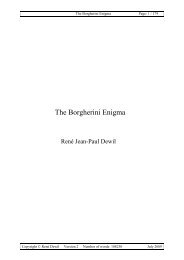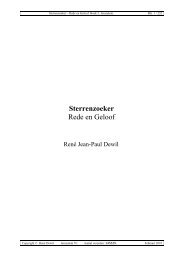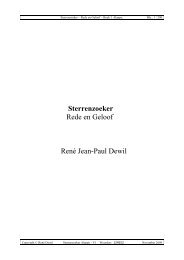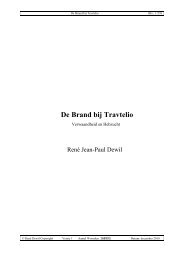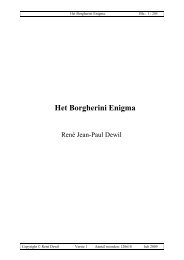A visual Journey into the Bible The Book of Genesis
A visual Journey into the Bible The Book of Genesis
A visual Journey into the Bible The Book of Genesis
Create successful ePaper yourself
Turn your PDF publications into a flip-book with our unique Google optimized e-Paper software.
A Visual <strong>Journey</strong> <strong>into</strong> <strong>the</strong> <strong>Bible</strong> Page: 12<br />
exactly as God had separated light from darkness It is not surprising <strong>the</strong>n that after a<br />
fa<strong>the</strong>r – Pieter <strong>the</strong> Elder – so much dedicated to pictures <strong>of</strong> immediate reality <strong>of</strong> earth,<br />
one son – Pieter <strong>the</strong> Younger – would show pictures <strong>of</strong> <strong>the</strong> underworld and <strong>the</strong> o<strong>the</strong>r –<br />
Jan <strong>the</strong> Elder – <strong>of</strong> paradise. Pieter <strong>the</strong> Younger and Jan <strong>the</strong> Elder were born in<br />
Brussels, but both worked in Antwerp. <strong>The</strong>y had sons in <strong>the</strong>ir turns that were artists.<br />
After Pieter I, his son, Pieter II, studied with his fa<strong>the</strong>r. Jan I Brueghel had a son Jan<br />
II. This son mostly only copied his fa<strong>the</strong>r and his technique is <strong>of</strong>ten indistinguishable<br />
from his fa<strong>the</strong>r’s. Jan II had a son Abraham (1631-1697) called <strong>the</strong> Neapolitan, who<br />
was a member <strong>of</strong> <strong>the</strong> San Luca Academy <strong>of</strong> Rome. Various o<strong>the</strong>r sons <strong>of</strong> <strong>the</strong><br />
Brueghels continued <strong>the</strong> artistic tradition way <strong>into</strong> <strong>the</strong> eighteenth century. <strong>The</strong>re was<br />
an Ambrosius Brueghel (1617-1675), Jan Baptist called Meleager (1647-1719),<br />
Philips (1635-1662), a Ferdinand (died 1637) and a Jan Peter Brueghel. <strong>The</strong> family<br />
did not only consist merely <strong>of</strong> artists in direct line <strong>of</strong> parentage. Jan van Kessel for<br />
instance was a grandson <strong>of</strong> Jan II while David Teniers (1610-1690), <strong>the</strong> son and pupil<br />
<strong>of</strong> David Teniers <strong>the</strong> Elder, married Anne, a daughter <strong>of</strong> Jan II. <strong>The</strong>ir son, David III<br />
(1638-1685) was equally a painter.<br />
Antwerp had become a metropolis port around <strong>the</strong> turn <strong>of</strong> <strong>the</strong> century, which burst <strong>of</strong><br />
energy, <strong>of</strong> trade and it was a hub <strong>of</strong> overseas transport. It was a financial centre where<br />
<strong>the</strong> world’s first stock trading house had been founded. This Antwerp would suffer<br />
much from <strong>the</strong> religious wars <strong>of</strong> <strong>the</strong> sixteenth century. Brabant was part <strong>of</strong> <strong>the</strong><br />
Spanish kingdom <strong>the</strong>n, a remnant <strong>of</strong> <strong>the</strong> empire <strong>of</strong> Charles V. <strong>The</strong> Ne<strong>the</strong>rlands fought<br />
for independence and for <strong>the</strong>ir Protestant views <strong>of</strong> Christian religion against <strong>the</strong><br />
Catholic Spanish armies and Antwerp had had a very important Protestant community<br />
too. Flanders and Brabant were rich but caught between <strong>the</strong> Ne<strong>the</strong>rlands and France,<br />
separated from Spain by a thousand kilometres but still governed buy it. <strong>The</strong> town<br />
would rise against Spain toge<strong>the</strong>r with <strong>the</strong> Ne<strong>the</strong>rlands, but <strong>the</strong> Spanish armies<br />
conquered it definitely in 1585. <strong>The</strong> Antwerp Protestants were <strong>the</strong>n more or less<br />
peacefully driven out and Antwerp would remain Catholic forever. Much wealth left<br />
with <strong>the</strong> Calvinist traders to Amsterdam, but sufficiently rich merchants and bankers<br />
remained to live in Contra-Reformist Antwerp to guarantee its splendour. <strong>The</strong>se were<br />
avid for paintings to decorate <strong>the</strong>ir houses, churches and community buildings.<br />
Antwerp rolled on with its acquired wealth and still grew in splendour.<br />
Jan Brueghel <strong>the</strong> Elder learned his pr<strong>of</strong>ession not from his fa<strong>the</strong>r, who had died<br />
young, but from <strong>the</strong> Antwerp masters Pieter Goetkint and Gillis van Coninxloo. He<br />
was inscribed in <strong>the</strong> Saint Lucas Guild <strong>of</strong> painters <strong>of</strong> Antwerp in 1557 already.<br />
Two features linked all <strong>the</strong> painters <strong>of</strong> <strong>the</strong> Brueghel family: Italy and landscapes.<br />
Pieter Bruegel <strong>the</strong> Elder had been to Italy from 1551 or 1552 to maybe as late as 1555<br />
or 1556. Pieter had travelled to Rome and he had been as far as Naples. He even<br />
visited Palermo on Sicily. Jan Brueghel <strong>the</strong> Elder also journeyed to Rome and he<br />
visited Milan from 1595 to <strong>the</strong> spring <strong>of</strong> 1596. He had met in Rome <strong>the</strong> Lombard<br />
collector Federico Borromeo. Pope Clement VIII appointed this Borromeo archbishop<br />
<strong>of</strong> Milan in that same year 1595. Federico admired Jan’s paintings, bought many <strong>of</strong><br />
his works and even stayed with him in correspondence after Jan’s stay in Milan. Jan<br />
occasionally bought Antwerp landscape paintings for <strong>the</strong> archbishop and sent <strong>the</strong>m to<br />
Milan. Federico Borromeo naturally also became a patron <strong>of</strong> Jan II. Archbishop<br />
Federico Borromeo (1564-1631) was a patron <strong>of</strong> many artists and he particularly liked<br />
nor<strong>the</strong>rn landscape painting, notably <strong>of</strong> Paul Bril and Jan <strong>the</strong> Elder. I8. <strong>The</strong> archbishop<br />
Copyright ©: René Dewil Date: October, 24 2000



